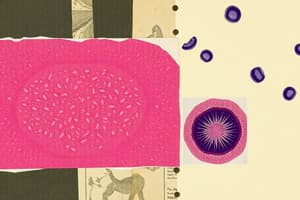Podcast
Questions and Answers
What type of tissue offers flexible, resistant support in joints and body cavities?
What type of tissue offers flexible, resistant support in joints and body cavities?
- Smooth muscle tissue
- Cardiac tissue
- Loose connective tissue (correct)
- Skeletal tissue
Which tissue is primarily responsible for voluntary movements like walking and grasping objects?
Which tissue is primarily responsible for voluntary movements like walking and grasping objects?
- Skeletal muscle tissue (correct)
- Nervous tissue
- Cardiac muscle tissue
- Smooth muscle tissue
What is the main function of glia in nervous tissue?
What is the main function of glia in nervous tissue?
- Facilitating digestion
- Providing structural stability (correct)
- Generating force for movement
- Transmitting information
Which connective tissue forms strong supportive structures like tendons and ligaments?
Which connective tissue forms strong supportive structures like tendons and ligaments?
Where is smooth muscle tissue predominantly found in the body?
Where is smooth muscle tissue predominantly found in the body?
Which type of muscle tissue contracts rhythmically to pump blood throughout the body?
Which type of muscle tissue contracts rhythmically to pump blood throughout the body?
What is the main function of epithelial tissue in animals?
What is the main function of epithelial tissue in animals?
Which developmental processes give rise to epithelial tissues in animals?
Which developmental processes give rise to epithelial tissues in animals?
Which type of epithelium provides increased protection against physical damage and infection?
Which type of epithelium provides increased protection against physical damage and infection?
What is the main function of glandular epithelia in animals?
What is the main function of glandular epithelia in animals?
Which type of epithelium is characterized by containing pigments for camouflage or signaling visual messages?
Which type of epithelium is characterized by containing pigments for camouflage or signaling visual messages?
What is the main function of connective tissue in animals?
What is the main function of connective tissue in animals?
Flashcards
Epithelial Tissues
Epithelial Tissues
Cover and line surfaces of organs and cavities, provide protection and sensation.
Connective Tissues
Connective Tissues
Support and connect body structures, made of cells in a matrix.
Muscle Tissues
Muscle Tissues
Enable movement by contracting and generating force.
Nervous Tissues
Nervous Tissues
Signup and view all the flashcards
Simple Epithelia
Simple Epithelia
Signup and view all the flashcards
Stratified Epithelia
Stratified Epithelia
Signup and view all the flashcards
Dense Connective Tissue
Dense Connective Tissue
Signup and view all the flashcards
Loose Connective Tissue
Loose Connective Tissue
Signup and view all the flashcards
Cartilage
Cartilage
Signup and view all the flashcards
Bone
Bone
Signup and view all the flashcards
Skeletal Muscle
Skeletal Muscle
Signup and view all the flashcards
Cardiac Muscle
Cardiac Muscle
Signup and view all the flashcards
Study Notes
Animal Tissues and Their Functions
Animals are complex organisms comprised of diverse cells that organize into distinct tissues, providing a range of structural and physiological functions. The four main types of animal tissues are epithelial, connective, muscular, and nervous tissues. Each tissue serves unique roles in protecting, supporting, moving, and communicating in the animal's body.
Epithelial Tissue
Epithelial tissue is responsible for covering and lining the surfaces of organs and cavities inside the animal's body. It plays a critical role in protection, barrier formation, and sensation. Epithelial tissues derive from the ectoderm, mesoderm, and endoderm during embryonic development. Examples include:
- Simple epithelia: Made up of a single layer of cells, they act as diffusion barriers, prevent abrasion, and aid in absorption (e.g., skin, respiratory tract).
- Stratified epithelia: Consisting of multiple layers, they offer increased protection against physical damage and infection (e.g., epidermis, esophagus).
- Glandular epithelia: Produce and secrete chemical substances like enzymes and hormones (e.g., sweat glands, salivary glands).
- Pigmented epithelia: Contain pigments that absorb or reflect specific wavelengths of light, allowing animals to camouflage or signal visual messages (e.g., chameleon scales).
Connective Tissue
Connective tissue holds together and supports the animal's body structures. It consists of cells embedded in an extracellular matrix, which provides flexibility and resistance to compression. Connective tissues evolve from mesoderm and are further categorized into dense, loose, cartilage, and osseous tissues:
- Dense connective tissue: Also known as fibrous connective tissue, it forms strong supportive structures like tendons and ligaments.
- Loose connective tissue: Provides support, padding, and a framework for the attachment of epithelia and muscles.
- Cartilage: Composed of specialized cells called chondrocytes suspended in a gelatinous substance, it offers flexible, resistant support in joints and body cavities.
- Bone: Consists of osteocytes surrounded by hardened minerals like calcium phosphate, forming rigid structures that protect vital organs.
Muscle Tissue
Muscle tissue enables movement in animals. It contracts and generates force, facilitating activities like locomotion, organ function regulation, and reproduction. There are three main types of muscle tissue: smooth, skeletal, and cardiac muscles:
- Skeletal muscle: Long fibers attached to bones, responsible for voluntary movements (e.g., walking, grasping objects).
- Cardiac muscle: Located in the heart, it contracts rhythmically to pump blood throughout the body.
- Smooth muscle: Found in the walls of internal organs, it controls involuntary processes like digestion, respiration, and micturition.
Nervous Tissue
Nervous tissue is responsible for transmitting information and coordinating the animal's responses to stimuli. It consists of specialized cells called neurons and glia, which communicate through electrical and chemical signals:
- Neurons: Transmit information from the sensory receptors to the muscles and glands, controlling the animal's behavior.
- Glia: Support neurons by providing structural stability, maintaining the blood-brain barrier, and facilitating nutrient transport.
In summary, the four main types of animal tissues - epithelial, connective, muscular, and nervous - contribute to the complex organization and functioning of animal bodies. Each tissue type plays a unique role in maintaining the integrity, protection, movement, and communication of the organism.
Studying That Suits You
Use AI to generate personalized quizzes and flashcards to suit your learning preferences.




